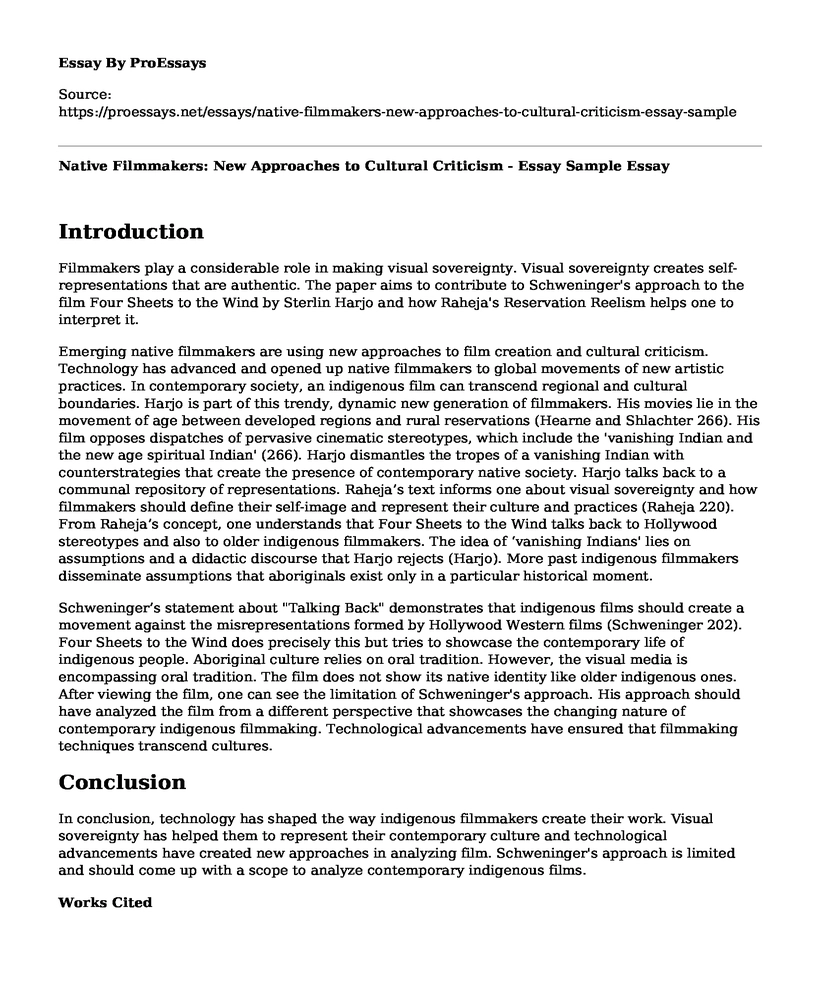Introduction
Filmmakers play a considerable role in making visual sovereignty. Visual sovereignty creates self-representations that are authentic. The paper aims to contribute to Schweninger's approach to the film Four Sheets to the Wind by Sterlin Harjo and how Raheja's Reservation Reelism helps one to interpret it.
Emerging native filmmakers are using new approaches to film creation and cultural criticism. Technology has advanced and opened up native filmmakers to global movements of new artistic practices. In contemporary society, an indigenous film can transcend regional and cultural boundaries. Harjo is part of this trendy, dynamic new generation of filmmakers. His movies lie in the movement of age between developed regions and rural reservations (Hearne and Shlachter 266). His film opposes dispatches of pervasive cinematic stereotypes, which include the 'vanishing Indian and the new age spiritual Indian' (266). Harjo dismantles the tropes of a vanishing Indian with counterstrategies that create the presence of contemporary native society. Harjo talks back to a communal repository of representations. Raheja’s text informs one about visual sovereignty and how filmmakers should define their self-image and represent their culture and practices (Raheja 220). From Raheja’s concept, one understands that Four Sheets to the Wind talks back to Hollywood stereotypes and also to older indigenous filmmakers. The idea of ‘vanishing Indians' lies on assumptions and a didactic discourse that Harjo rejects (Harjo). More past indigenous filmmakers disseminate assumptions that aboriginals exist only in a particular historical moment.
Schweninger’s statement about "Talking Back" demonstrates that indigenous films should create a movement against the misrepresentations formed by Hollywood Western films (Schweninger 202). Four Sheets to the Wind does precisely this but tries to showcase the contemporary life of indigenous people. Aboriginal culture relies on oral tradition. However, the visual media is encompassing oral tradition. The film does not show its native identity like older indigenous ones. After viewing the film, one can see the limitation of Schweninger's approach. His approach should have analyzed the film from a different perspective that showcases the changing nature of contemporary indigenous filmmaking. Technological advancements have ensured that filmmaking techniques transcend cultures.
Conclusion
In conclusion, technology has shaped the way indigenous filmmakers create their work. Visual sovereignty has helped them to represent their contemporary culture and technological advancements have created new approaches in analyzing film. Schweninger's approach is limited and should come up with a scope to analyze contemporary indigenous films.
Works Cited
Harjo, Sterlin. Four Sheets To The Wind. Indion Entertainment Group (SMIL Desk), 2007.
Hearne, Joanna, and Zack, Shlachter. "‘Pockets Full of Stories’: An Interview with Sterlin Harjo and Blackhorse Lowe." Native Americans on Film: Conversations, Teaching, and Theory. 2013, pp. 256-287. https://www.researchgate.net/publication/297970807_Pockets_full_of_stories_An_Interview_with_Sterlin_Harjo_and_Blackhorse_Lowe
Raheja, Michelle H. Reservation Reelism: Redfacing, Visual Sovereignty, and Representations of Native Americans in Film. U of Nebraska Press, 2011.
Schweninger, Lee. Imagic Moments: Indigenous North American Film. University of Georgia Press, 2013.
Cite this page
Native Filmmakers: New Approaches to Cultural Criticism - Essay Sample. (2023, Aug 28). Retrieved from https://proessays.net/essays/native-filmmakers-new-approaches-to-cultural-criticism-essay-sample
If you are the original author of this essay and no longer wish to have it published on the ProEssays website, please click below to request its removal:
- Modernism and Architecture of Antiquity
- Brahms and Wagner Comparative Essay
- Tempting Fate: Everest Essay
- Critical Essay on A Tale of Two Sisters: South Korean Drama of Sisters & Stepmother's Challenges
- Paper Sample on Tom Cruise's Minority Report: Futuristic Crime-Fighting Technology
- Movie Review Example on Apocalypto: Mayan Kingdom in Crisis (1502s)
- Free Essay Sample on Media Fear of Crime: Linked Subjects and US Crime Rate







